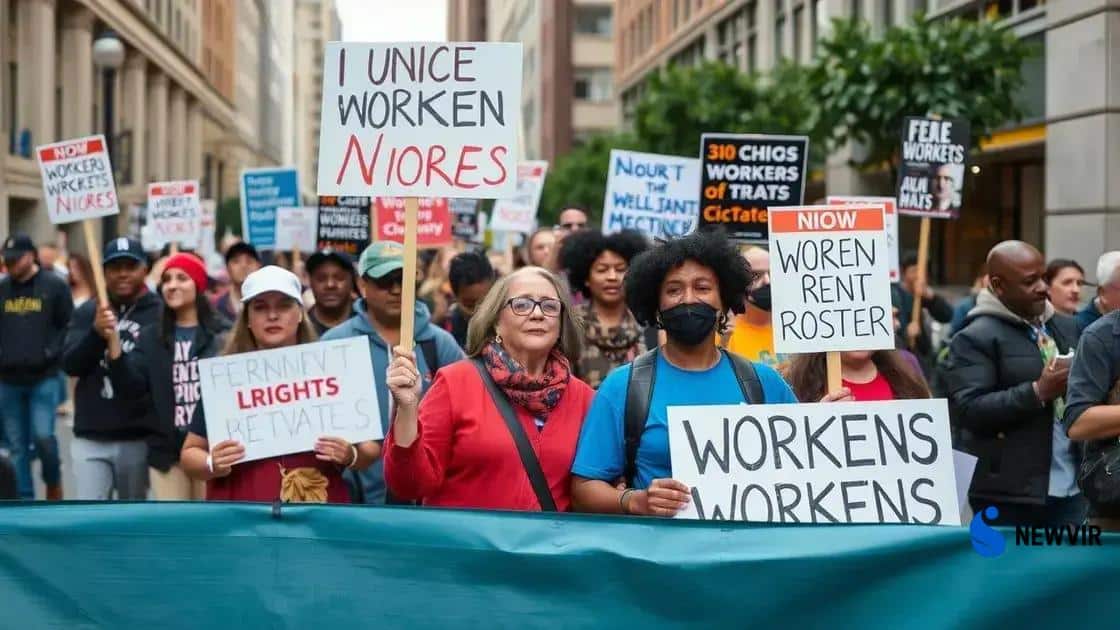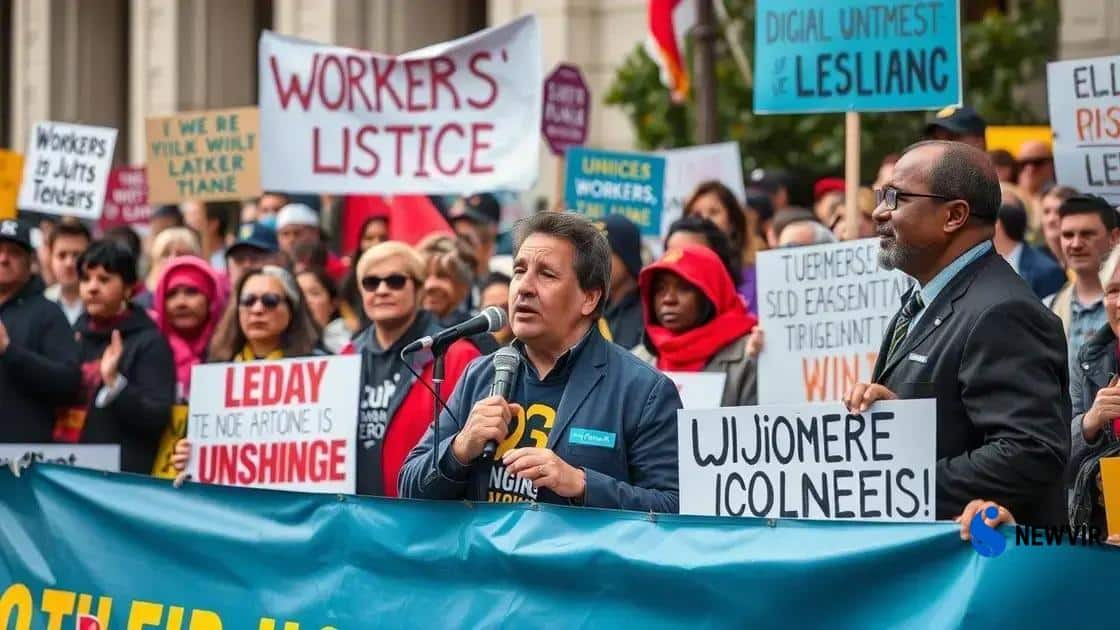Labor union engagement in national protest efforts

Labor union engagement in national protest efforts strengthens advocacy for workers’ rights, builds solidarity among diverse groups, and addresses broader social issues like climate change and racial justice.
Labor union engagement in national protest efforts showcases the powerful influence unions have in advocating for workers’ rights and social justice. How do these organizations mobilize to create significant change?
Understanding the role of labor unions in protests
Labor unions play a vital role in social movements and national protests. They are not just organizations for workers but also key players in advocating for change. Understanding how they engage in protests can shed light on their importance in society.
The Influence of Labor Unions
Labor unions mobilize workers around common goals. This collective power allows them to advocate effectively for workers’ rights and social justice. When unions participate in protests, they amplify their voices, drawing attention to issues impacting not just their members but the broader community.
Key Functions of Unions in Protests
- Advocating for workers’ rights and fair wages
- Raising awareness about social injustices
- Building coalitions with other organizations
- Providing resources and support for protestors
During protests, unions also serve as a unifying force. They provide a platform for individuals to express their concerns. This solidarity helps to create a sense of community among protestors, fostering collaboration and support. With a strong foundation, unions can push for significant changes, influencing policy and public opinion.
Moreover, unions boost participation in protests. By organizing events and rallies, they ensure a larger turnout. A higher number of participants increases the visibility of the issues at stake. Collaborative efforts also make the protest messages clearer, resonating more with the public and contributing to the overall impact.
Historical Examples of Union Engagement
Throughout history, labor unions have been involved in pivotal protests. Notable examples include the Civil Rights Movement, where unions offered crucial support. By aligning their objectives with social justice, they were able to advocate for significant changes in legislation. This involvement not only advanced workers’ rights but also highlighted the importance of solidarity across different social movements.
In recent years, we have seen unions engage in issues like climate change and immigration reform. By addressing these critical topics, unions broaden their appeal and relevance. Their participation helps frame these issues as part of a larger struggle for equity and justice.
Historical examples of labor involvement in protests
Understanding historical examples of labor involvement in protests helps us appreciate the impact unions have had on social change. Throughout history, labor unions have stepped up to advocate for not only workers’ rights but also broader societal issues.
The Pullman Strike of 1894
This significant event showcased how powerful unions could be. The strike began when workers at the Pullman Company protested low wages and high rents in company housing. The situation escalated when federal troops were sent to break the strike, leading to violence. This pivotal moment underscored the need for better labor rights and set the stage for future labor movements.
The United Farm Workers Movement
In the 1960s, the United Farm Workers (UFW) led a major campaign for better working conditions for agricultural laborers. Under the leadership of figures like Cesar Chavez, farmers organized strikes and boycotts to demand fair wages and safe working environments. Their efforts highlighted the struggles of migrant workers and resulted in significant legal protections.
- Established the National Labor Relations Act, protecting workers’ rights.
- Inspired solidarity among diverse labor groups.
- Resulted in improvements to labor laws and working conditions.
Labor involvement in the Civil Rights Movement is another example of their pivotal role. Many unions actively participated in the fight against racial discrimination. They recognized that economic justice and civil rights were intertwined. By standing in solidarity with civil rights leaders, unions helped achieve critical milestones, such as the passage of the Civil Rights Act.
Another notable instance is the 2011 Wisconsin protests against proposed budget cuts that threatened collective bargaining rights for state workers. Unions mobilized thousands of individuals to rally at the state capitol, demonstrating the power of organized labor in defending workers’ rights against political attacks. This event reignited discussions about the importance of unions and their role in protecting worker interests.
Benefits of union participation in national movements

The benefits of union participation in national movements are significant and multifaceted. Unions bring together workers, creating a strong collective voice that can advocate for change. Their involvement in national movements enhances the visibility of critical issues.
Strengthening Advocacy
Unions amplify the voices of their members, making it easier to push for reforms. By participating in national movements, they ensure that workers’ rights are prioritized in public discussions. This involvement leads to stronger advocacy for policies that benefit not only union members but also society as a whole.
Building Solidarity
When unions engage in national movements, they build solidarity among diverse groups. This unity is essential for creating a powerful front to tackle pressing issues like labor rights, healthcare, and education. By collaborating with other organizations, unions can create broader coalitions that strengthen their impact.
- Enhances public awareness about worker issues.
- Creates opportunities for policy change.
- Fosters community engagement and support.
- Unites workers across different sectors.
Unions also provide essential resources for organizing and mobilizing protests. They often have access to funding, training, and networks that allow them to plan effective campaigns. This infrastructure enables unions to respond swiftly to urgent issues, making their participation invaluable during critical moments.
Moreover, unions play a crucial role in advocating for social justice beyond labor rights. Their participation in issues like racial equality, environmental justice, and healthcare access shows their commitment to broader social change. This holistic approach resonates with the public and helps gain wider support for their causes.
Challenges faced by unions during protests
Unions face various challenges during protests that can complicate their efforts to advocate for workers’ rights. Understanding these challenges is crucial to see how unions navigate complex social and political landscapes.
Legal and Political Obstacles
Unions often encounter legal restrictions when organizing protests. Laws may limit their ability to assemble or march without permits. Political opposition can also create barriers. Some governments may be unsupportive, leading to confrontations that hinder progress. These obstacles can make it difficult for unions to mobilize effectively.
Public Perception and Media Coverage
The way unions are portrayed in the media can impact their effectiveness during protests. Negative coverage can distort public opinion, making it harder for unions to gain support. Unions must actively counter misinformation and highlight their positive contributions to society. Engaging with the community is vital to improve their image.
- Unions need to manage their public relations carefully.
- Maintaining a positive image helps garner support.
- Building relationships with local communities is essential.
- Social media plays a crucial role in shaping perceptions.
Moreover, unions often battle internal divisions. Different factions within a union may have varying priorities, which can lead to conflicts. Maintaining unity is critical for a cohesive message during protests. It’s important for union leaders to communicate effectively and ensure that all members feel included and valued.
Resource management is another significant challenge. Protests often require financial and logistical support. Unions must allocate funds wisely to cover expenses like permits, promotional materials, and event logistics. Achieving this balance can be tough, especially for smaller unions with limited resources.
Future of labor unions in advocacy efforts
The future of labor unions in advocacy efforts holds significant promise and potential obstacles. Unions are adapting to changing social and economic landscapes to remain relevant and effective in their mission.
Embracing Technology
One major trend is the embrace of technology. Unions are increasingly using digital tools to organize and mobilize members. Online platforms allow for quicker communication and engagement. This shift can help unions reach younger workers who are more connected online.
Expanding Advocacy Issues
Unions are broadening their focus beyond traditional labor rights. They are increasingly involved in issues like climate change, racial justice, and healthcare access. By aligning with other social movements, unions can strengthen their advocacy. This approach creates a united front for addressing complex social challenges.
- Collaborating with community organizations fosters solidarity.
- Addressing a wider range of issues increases public support.
- Building coalitions enhances impact in advocacy efforts.
- Mobilizing across social movements can bring fresh energy.
Moreover, as work becomes more globalized, unions are likely to engage in international solidarity. International labor movements can offer support and resources for local unions. By working together globally, unions can tackle issues like exploitation and labor rights across borders.
As unions adapt to these changes, they also face challenges. Membership numbers have been declining in many areas. Unions must figure out how to attract and retain members. Providing clear benefits and demonstrating relevance in modern work environments will be crucial for their survival.
In summary, the role of labor unions in advocacy is evolving. By embracing technology and addressing broader social issues, unions are positioning themselves for the future. They are not only fighting for labor rights but also tackling challenges like climate change and inequality. Although unions face internal and external obstacles, their ability to adapt can lead to significant advancements for workers and society as a whole. With a focus on collaboration and unity, unions can continue to be a powerful force for change.
FAQ – Frequently Asked Questions about Labor Union Engagement in Advocacy Efforts
What are the main benefits of union participation in national movements?
Union participation amplifies workers’ voices, builds solidarity across different sectors, and addresses broader social issues like climate change and racial justice.
How do unions use technology to adapt for the future?
Unions are embracing digital tools to organize more effectively, communicate with members, and engage younger workers in new ways.
What challenges do unions face during protests?
Unions encounter legal restrictions, negative media coverage, internal divisions, and resource management issues that can complicate their advocacy efforts.
How can unions expand their advocacy focus?
Unions can collaborate with community organizations and align with social movements to address a wider range of issues, enhancing their impact.






